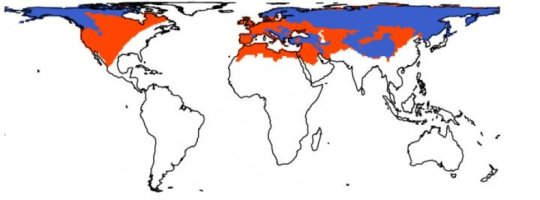[ad_1]
Researchers from Aarhus University and University of Gothenburg have produced the most comprehensive family tree and atlas of mammals to date, connecting all living and recently extinct mammal species — nearly 6,000 in total — and overturning many previous ideas about global patterns of biodiversity.
While others have tried to map the ranges of all mammals or figure out their family tree, previous studies always left out one crucial group of mammals: species driven to extinction by humans.
“This is the first time we’ve been able to comprehensively include extinct species like the Tasmanian tiger or the woolly mammoth as well as account for human-induced regional range losses among extant species in such a large database, and it’s really changing our beliefs about what is ‘natural’ or not,” said biologist Søren Faurby of the University of Gothenburg in Sweden, who co-led the assembly of the database and the study, which was resently published in the scientific magasine Ecology.
Scientist often use maps of mammal species ranges to investigate patterns of biodiversity or to predict how climate change will affect species. But these maps are incomplete because they don’t show species’ natural ranges, only where they occur today. Many species have had their ranges drastically reduced by humans, for instance, through overhunting and habitat destruction.
“Brown bears may be emblematic of Alaska or Russia today but their range used to stretch all the way from Mexico to Northern Africa before widespread hunting by humans. If we want to predict how a warming climate will affect these bears, we can’t leave out these natural areas of their range,” said Faurby.
Tasmanian tigers and mammoths back on the map
It is also important to include species that have been totally exterminated.
“If we are studying global patterns of biodiversity, we really need to start considering species like the Tasmanian tiger that was hunted to extinction less than 100 years ago, a mere eye blink in geological time,” said paleontologist and co-leader Matt Davis of Aarhus University in Denmark.
We associate large mammals like elephants and lions with Africa today, but for most of the last 30 million years, big animals roamed all over the Earth. It was only relatively recently that humans drove many of these large mammals extinct, leaving a world depauperate of giants.
“Even a species like the woolly mammoth, that we think of as prehistoric, lived up to the time the Great Pyramid was being built,” Davis said.
Old maps and new algorithms
Assembling a database that included every species of mammal was no easy task. It took the research team, headquartered at Aarhus University, months just to stitch together existing datasets and fill in missing holes in the data.
They then poured over old maps and checked museum records to see where species natural ranges might be without the interference of modern humans.
Adding extinct species to the mammal family tree and making modern ranges for them was even harder. The scientists combined DNA evidence and data from fossil dig sites around the world with a powerful new computer algorithm to predict where extinct species fit in with mammals that are alive today.
New baselines for restoration
“This comprehensive database has already provided much needed evidence to inform restoration baselines and to provide re-assessments of several hotly debated ideas in biology, but this is just the beginning” said Jens-Christian Svenning, professor at Aarhus University and leader of the Aarhus team.
He expects that other researchers, conservationists, and educators will also find the easy to use and publicly available database valuable.
“We are already using the database to quantify and map human-induced biodiversity deficits and assess restoration potential across the globe.
Story Source:
Materials provided by Aarhus University. Note: Content may be edited for style and length.
[ad_2]















